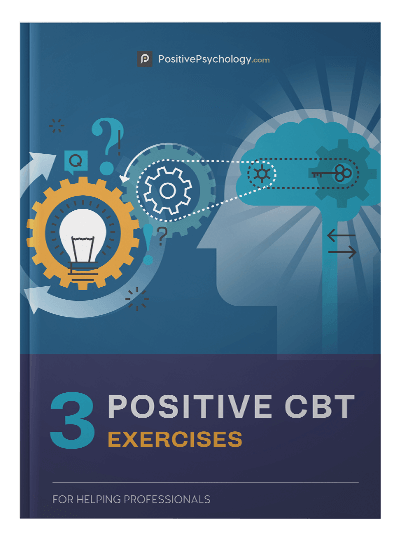Carl Rogers’s Actualizing Tendency: Your Ultimate Guide
 Psychotherapist and humanistic psychologist Carl Rogers began his career working with children.
Psychotherapist and humanistic psychologist Carl Rogers began his career working with children.
Later, as his work shifted to include working with adults and teaching, he began articulating his therapeutic approach.
As he increased his skills and experience, a solid approach surfaced: Client-Centered Therapy (later called Person-Centered Therapy).
In 1942, he published his first book on the subject, Counseling and Psychotherapy.
In true humanistic psychology fashion, Rogers welcomed his theories being adapted by others to fit their needs. It was his openness to possibilities and empathic nature that both drew people to him and encouraged criticism of his theories.
Before you continue, we thought you might like to download our three Positive CBT Exercises for free. These science-based exercises will provide you with detailed insight into Positive CBT and give you the tools to apply it in your therapy or coaching.
This Article Contains:
- What Is Humanistic Psychology?
- Two Views of Self-Actualization
- What Is Actualizing Tendency?
- Self-Concept and Incongruence
- 3 Core Conditions
- 6 Necessary and Sufficient Conditions for Therapeutic Personality Change
- What Is Person-Centered Therapy?
- Criticisms of Person-Centered Therapy
- Client-Centered Therapy Today
- A Take-Home Message
- References
What Is Humanistic Psychology?
To understand Carl Rogers’s ideas and approach to therapy, it is important to understand what he valued and believed about human nature. Schunk (2016, p. 346) asserts that humanistic psychology is constructivist and based on two assumptions:
- Studying people must be done from a holistic perspective. This means taking into account their thoughts, feelings, and behaviors.
- Human choices, creativity, and self-actualization are important areas of study. Research should focus on “psychologically functioning humans” who are working to be creative and reach their full potential.
Carl Rogers and Abraham Maslow are two famous humanist psychologists. While they both viewed the study of humans from a holistic perspective, as you will read later, they defined self-actualization differently.
The Society for Humanistic Psychology (n.d.) aims to “be faithful to the full range of human experiences” and to develop “systematic and rigorous methods of studying human beings.” The core values of the society honor the complexity of all people as individuals and in groups.
Two Views of Self-Actualization
From Rogers’s perspective, every person strives to be a creative, fully functioning being who desires to reach their potential. This striving is ongoing, motivational, and innate (Rogers, 1963, as cited in Schunk, 2016). The process of pursuing our full potential is what he called the actualizing tendency.
The orientation of all people is “growth, autonomy, and freedom from control by external forces” (Schunk, 2016, p. 349). This might remind you of self-determination theory, with its focus on autonomy, relatedness, and competence.
Maslow’s hierarchy of needs places self-actualization at the apex. It is an ideal that emphasizes personal growth but is not based on a person’s sense of deprivation, as is the case for the first four needs (physiological, safety, belongingness, and self-esteem).
In fact, not everyone achieves self-actualization, and Maslow did not describe this need as innate or underpinning all other motivations. Globe (as cited in Schunk, 2016, p. 347), states that about 1% of people reach self-actualization. To see where you rank, try these self-actualization tests and tools.
Conversely, Rogers believed that the actualizing tendency acted as the motivating force for all behavior. It is affected by the environment and the people surrounding the individual. The actualizing tendency is not an end goal reserved for a select few but, rather, how life begins. Organisms start with a longing (motivation) to reach completeness in whatever manner suits that organism.
What Is Actualizing Tendency?
The basic idea of the actualizing tendency is straightforward. It is a desire present in all living things that pushes the organism toward growth. In the case of humans, we all want to express ourselves creatively and reach our full potential.
Rogers offered the analogy of a potato when explaining this tendency. Have you ever left a potato in your pantry only to discover later that it has grown sprouts? The sprouts are little white nubs taking advantage of the small amount of light available beneath and around the door frame.
Every time you open the door, some light enters, encouraging the seedling to fight for survival. If you were to plant that potato in the soil in the spring, you would soon find green sprouts fighting through the surface, followed by bushy green leaves.
We can see this desire to lean toward growth in everyone, and Rogers believed it true of every organism (Goodreads, n.d.). Organisms have an innate motivation to live in accordance with their true nature. When the organism cannot do this, it experiences incongruence but continues to push toward actualizing (the white nubs) even though the environment is more complicated.
We see this when flowers shoot up between cracks in concrete, when corn stalks grow between road grates, and when a tree grows inside of the stump of another tree. We also see this when people struggle to define who they are amidst being told who they are. Often, it is this struggle that leads a person to seek out therapy.
Just like those flowers growing between the cracks, the actualizing tendency cannot be destroyed unless the organism is destroyed.
Self-Concept and Incongruence
Self-concept is how we see ourselves. When this differs from our experience in the world, the resulting feeling is incongruence. There is a disconnect, which can be large or small, between our self-concept and our experience. This can cause discomfort.
If a person had no interaction with any other living being, then this incongruence would not happen. It is our interaction with others via direct and indirect actions that influences our self-concept. This influence can be positive or negative. When it is in opposition to who we believe we are (our self-concept), then we experience suffering.
This is true even if the influence is positive but, in the person’s mind, unbelievable. If a person spends the majority of their young life being told they are worthless, but then someone comes along telling them they are not, then the person could experience incongruence.
Incongruence often relates to conditions of worth. These are behaviors a person displays because they are expected by others. For example, if you are a woman, you may feel you are expected to smile because it makes you look prettier and more approachable.
What if smiling is not something that interests the woman? What if her natural resting face is a frown? What if she is not concerned with her outward appearance?
Conditions of worth are pieces of paper decoupaged to your surface. They can be placed haphazardly or in some beautiful arrangement, but regardless of how they are placed, they are not you.
They are simply layers of paper. Each paper represents some condition you are told you need to meet so that you feel worthy. They come from parents, friends, bosses, spouses, partners, religion, and media. Before long, the papers overlap, and you no longer see what is hiding beneath.
3 Core Conditions
In 1974, Rogers facilitated a lecture highlighting research on empathy. Some of that research showed that progress through therapy is positively correlated with the level of empathy shown by the therapist.
Here is the first video of the four-part series:
Before Rogers’s work and insights into the therapeutic relationship, psychoanalysis and behaviorist approaches dominated the field. The idea that the client could guide the process and was an expert about themselves was unusual. Rather than focus efforts on behaviors or past experiences that may have negatively affected the person, Rogers worked with the client in the present moment.
Rogers was clear about what he believed made a therapy session suitable for the client. To him, three elements must be present. These have come to be known as the core conditions by therapists using his approach. They are:
- Unconditional positive regard – Acceptance and nonjudgmental behavior from the therapist allows the space the client needs throughout the exploration process.
- Empathy – This outlook is a way of being with the client. The therapist need not agree with the client but does need to express genuine understanding.
- Congruence – Authentic interactions between the client and the therapist are a normal part of the process. The therapist acts in accordance with their values and beliefs throughout the relationship. Congruence is about the therapist’s thoughts and feelings while working with the client.
6 Necessary and Sufficient Conditions for Therapeutic Personality Change

Will they be involved for months or years? When will they know that they are ‘better?’ In response to this, Rogers believed that the following conditions were necessary for any therapeutic relationship.
- Two people are in psychological contact/relationship.
- The client is in a state of incongruence. They are vulnerable or anxious.
- The therapist is integrated into the relationship. The therapist is congruent (i.e., aware of their own experience and accepting of it).
- The therapist experiences unconditional positive regard toward the client. The therapist acts congruently.
- The therapist is empathetic to the client’s frame of reference and communicates this to the client. The therapist makes every effort to understand the world as seen through the eyes of their client.
- The therapist expresses acceptance and understanding of the client’s perspective in such a way that the client expresses feeling accepted and understood.
Rogers asserted that these conditions are all that is necessary for a client’s personality to change. Therapy is useful when these conditions are in play. The length of time it takes for a client to do this varies.
What Is Person-Centered Therapy?
An article in the Harvard Mental Health Letter (Client-centered therapy, 2006) described what client-centered therapy is and is not. You might be guided by a Rogerian approach if you rarely, if ever:
- Ask the client questions
- Diagnose the client
- Use psychological tests
- Interpret, evaluate, or advise
- Offer reassurance, praise, or blame
- Agree/disagree with the client
- Express opinions about the situation
- Point out contradictions
- Discuss unconscious motives
- Talk about the client’s feelings about the therapist
Client-centered therapy is a non-directional form of therapy. Rogers viewed the client as an expert on themselves. As such, the client decides the direction therapy flows.
It takes practice and patience to become a skilled Rogerian therapist. People interested in doing so might find mindfulness practices, particularly loving-kindness meditation, beneficial as part of their preparation. Practicing self-compassion and mindfulness could help the therapist be and remain present in the moment with the client.
Because a Rogerian approach requires attention to the feelings behind what is said by a client, some training in micro-expressions or general body language analysis could also prove useful.
Criticisms of Person-Centered Therapy
There are several concerns about this therapeutic approach, beginning with a lack of suitable training. Rogers himself did not feel specific training was needed (Client-centered therapy, 2006).
Its principles have been extrapolated from interviews with and books by Rogers. This leaves ample room for interpretation.
Not every client is comfortable talking about themselves. This could lead to awkward, uncomfortable silence in therapy.
Some therapists believe the six conditions are needed but not sufficient. These therapists often utilize other tools and techniques to support therapy. This type of therapy is often called integrative therapy. It is no longer person-centered therapy in the true sense.
There also is little evidence-based research supporting the effectiveness of this form of therapy (Client-centered therapy, 2006). The central question is, “Do the conditions lead to improvement, or are they a consequence of it?”
Client-Centered Therapy Today
Many practitioners initially attracted to Rogers’s theories regard his contributions as invaluable to the development of therapy. While they might not follow each of the conditions, instead opting to blend them into their eclectic style, they understand the importance of appropriate self-disclosure in the relationship. They also recognize the value of respecting the client as the expert in the relationship.
Motivational interviewing (MI), a client-centered, directive approach, leans on the principles used by Rogers. Rollnick and Miller (1995), the developers of MI, outlined seven characteristics of the method. This approach is “more focused and goal-directed” than traditional client-centered therapy, but you might note its similarities to Rogers’s style. Rollnick and Miller (1995) describe these as the “spirit of motivational interviewing.”
- Motivation to change is elicited from the client and not imposed from outside.
- It is the client’s job to articulate and resolve their ambivalence.
- Direct persuasion does not work.
- The counseling style is generally quiet and somewhat passive.
- The counselor is directive but only in such a way as to help the client examine and resolve ambivalence.
- Readiness to change is not a client trait. It is a fluctuating product of interpersonal interaction.
- The therapeutic relationship is a partnership. The counselor is not an expert about the client.
MI is typically used in the early phases of the change process. See LaMorte’s (2019) Transtheoretical Model of Change for more details.
A Take-Home Message
Regardless of the therapeutic styles you learn during undergraduate and graduate studies, until you work with clients, your own style cannot develop. This is one reason why programs require many hours of client–therapist interaction.
Carl Rogers’s insights into the client–therapist relationship, specifically that there is a relationship, are important. Acknowledging that the interaction between the two people can and does affect the possible outcomes advanced future therapeutic techniques and approaches. Describing the person as a ‘client’ instead of a ‘patient’ shifted the mindsets of both parties.
Understanding and believing that all organisms have an actualizing tendency toward growth and that this tendency is ongoing influences many positive psychology practices today. Work in the areas of mindset, resilience, flow, creativity, and strengths presuppose this.
How has the work of Carl Rogers, specifically his belief in an actualizing tendency, influenced you?
We hope you enjoyed reading this article. For more information, don’t forget to download our three Positive CBT Exercises for free.
- Client-centered therapy. (2006). The Harvard Mental Health Letter, 22(7), 1–3.
- Goodreads. (n.d.). Carl R. Rogers Quotes. Retrieved December 9, 2019, from https://www.goodreads.com/quotes/6641851-whether-we-are-speaking-of-a-flower-or-an-oak
- LaMorte, W.W. (2019, September 9). The transtheoretical model (Stages of change). Retrieved December 10, 2019, from http://sphweb.bumc.bu.edu/otlt/MPH-Modules/SB/BehavioralChangeTheories/BehavioralChangeTheories6.html
- Rollnick, S., & Miller, W. R. (1995). What is motivational interviewing? Behavioral and Cognitive Psychotherapy, 23(4), 325–334.
- Society for Humanistic Psychology. (n.d.). About us. Retrieved December 8, 2019, from https://www.apadivisions.org/division-32/about/
- Schunk, D. H. (2016). Learning theories: An educational perspective. Pearson.
Let us know your thoughts
Read other articles by their category
- Body & Brain (49)
- Coaching & Application (57)
- Compassion (26)
- Counseling (51)
- Emotional Intelligence (24)
- Gratitude (18)
- Grief & Bereavement (21)
- Happiness & SWB (40)
- Meaning & Values (26)
- Meditation (20)
- Mindfulness (45)
- Motivation & Goals (45)
- Optimism & Mindset (34)
- Positive CBT (29)
- Positive Communication (20)
- Positive Education (47)
- Positive Emotions (32)
- Positive Leadership (18)
- Positive Parenting (4)
- Positive Psychology (33)
- Positive Workplace (37)
- Productivity (17)
- Relationships (46)
- Resilience & Coping (36)
- Self Awareness (21)
- Self Esteem (38)
- Strengths & Virtues (32)
- Stress & Burnout Prevention (34)
- Theory & Books (46)
- Therapy Exercises (37)
- Types of Therapy (64)





What our readers think
“From Rogers’s perspective, every person strives to be a creative, fully functioning being who desires to reach their potential. This striving is ongoing, motivational, and innate (Rogers, 1963, as cited in Schunk, 2016). The process of pursuing our full potential is what he called the actualizing tendency.”
I’m not sure this is true. Not every person strives to be a creative, fully functional person. Some might want to be a warlord, or a successful drug dealer. Hear me out.
Mearns and Thorne use an example of a child who has been emotionally and/or physically abused by their parent. This child survived by ‘going underground’ as a person, running drug dealing operations, exerting his authority ‘at times with considerable public cruelty’. So. Not a fully functioning person.
I just wanted to add this comment because studying person centred personality theory can be confusing. Hope this helps. 🙂
Thank you for this article this was super valuable for my psychology course!
I’m starting to feel like I’m not from this planet. This is the second fairly major psychology publication in which the author fails to cite or reference anything from the originators of the theories the article is about!! At a minimum, I was expecting to see at least one reference to Rogers’ original work!! But instead, Dale Schunk is cited which hardly a credible source.
First of all, that’s the textbook from an undergrad psych. course….I should know because I took the course as a requirement. Having established as much, I could go on for DAYS about Schunk’s less than credible research and fallacy infested conclusions. Throughout his text are countless instances of secondary and tertiary citations aside from the fact that he cites himself at least 48 times if not more from double or triple citing. I would NEVER use his work as a primary source.
If you’re going to discuss Rogers’, Maslow’s, Freud’s, Jung’s, or anyone else’s theories then why wouldn’t you pull your source material directly from their work? It’s not hard to find. Do the editors prohibit citations from original sources? Why does this seem to be industry standard?
Hi, Brian.
Thank you for your feedback about my research for this article. I strive to provide valid, concise resources within the timeframes I work, and I understand that you feel I failed to do this. If you have additional opinions about my articles, I invite you to contact me directly. As someone who values lifelong learning, I appreciate knowing how I can incorporate other people’s perspectives into my writing. Again, thank you for taking time to share your point of view with me.
Your approach to feedback is unnecessarily aggressive. I appreciate the sentiment behind your comments and don’t disagree with your point of going straight to the source, which, perhaps the author has done previously but in the case of this article, referred to more modern articles that were to hand to inform this short piece. The delivery of your feedback comes across as rude. It’s interesting you felt you had to point out how ‘you should know’ because you have this and that and the other. Just because some references may be used as undergraduate material doesn’t mean they are not valid. Undergraduate material is the foundation for a good solid grounding of knowledge and you build on from that.
I loved your reading your article. It was written so beautifully and I got all the info that I needed in a compact but not depth lacking format. Thank you so much!
Hi Fatmima,
Great to hear you got what you needed from this article. Thanks for reading.
– Nicole | Community Manager
I enjoyed reading your article. It was thoughtfully written.
This is gold, I suppose sometimes especially when one is experiencing hard times, forget their inner strength and Carl rogers confirms this. I provide mental well-being support to a lady who always says she feels she could not to this or that and then finds herself doing the things she thinks could not do.
I Loved reading this article. I am currently coaching a minor who is in foster care. One of the things I said to her is the flower blossoming through the cracks in the concrete. My heart jumped for joy when I read this, it is an absolute confirmation of the resilience of this young person going through incredibly uncertainty at such a young age. Thank you for sharing.
After reading through this and watching the video I didn’t realise that I was more empathetic than I realised. On a different note I’ve had this recurring image in my head of a plant/flowers growing in the most unlikely places. It reminded of Bali. How things can grow and survive. It reminded me of the human spirit that no matter what is thrown at us we do have the ability to adapt and change to reach our potential, we just need to know how to do it. Having people help goes a long way towards this.